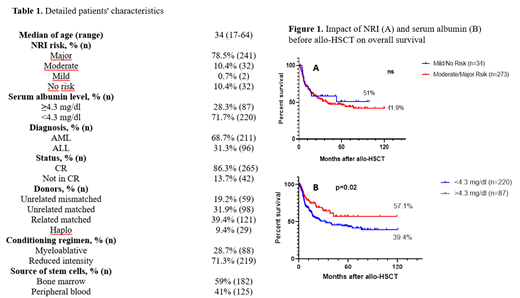Background: Nutritional problem is a key aspect of all severe diseases that always "keep in the shadows". There are different factors, such as intensive chemotherapy, constant nausea, severe infections, time for donor search that affect nutritional status in leukemia patients who underwent allogeneic stem cell transplantation (allo-HSCT). This study aimed to evaluate the impact of different "nutritional status assessment tools" on outcomes of allogeneic hematopoietic cell transplantation.
Materials and methods: 307 leukemia patients who underwent allo-HSCT in National Research Center for Hematology from 2011-2019 were included on this study. Detailed patients' characteristics are given in Table 1. All data were collected directly before allo-HSCT conditioning regimen. Nutritional Risk Index (NRI) was calculated by NRI = (1.519 × serum albumin, g/dL) + (41.7 × present weight (kg)/ideal body weight(kg)). Ideal body weight (IBW) was calculated by Lorentz IBW formula: for men IBW = (height, cm− 100) − ((height − 150)/4); for women: IBW = (height, cm − 100) − ((height, cm − 150)/2). All patients were stratified according to NRI: NRI < 83.5 - Major; 83.5 ≤NRI < 97.5 - Moderate; 97.5 ≤NRI < 100 - Mild; NRI≥100 - No risk group. Moreover all patients were stratified according to serum albumin level (more and less than 4.3 mg/dl ). Groups stratified by NRI and serum albumin was balanced for factors that can affect long-term results: disease type and status, graft source, conditioning regimen, donor's type, graft failure, acute and chronic GVHD. Data analysis was performed with R version 3.5.2 (Core Team, 2018). Chi-square and Fisher's exact test were used for contingency tables. Kaplan-Meier analysis was provided to assess the probability of overall survival. Log-rank test was used to compare two groups. Cox regression model was used to identify independent prognostic factors and its hazard ratio (HR) with a 95% confidence interval (95% CI). Age, sex, disease status before allo-HSCT (CR vs not in CR), serum albumin level (83.5 <4.3 vs ≥4.3 mg/dl), NRI, donor type (MUD, MMUD, Haplo vs MRD), conditioning regimen (MAC vs RIC) was included as independent covariates.P-value of 0.05 was considered as significant.
Results: As we can see on Figure 1A NRI-based stratification can't help us to predict long-term results in contrast with serum albumin level (Figure 1B). At the same time level of albumin >4.3 was associated with better results compared to serum albumin level <4.3 mg/dl (p=0.02). According to Cox model there are several independent prognostic factors : disease status before allo-HSCT (CR vs not in CR) - HR=3.79 (95% CI 2.45-5.8; p=0.0001); donor type (MMUD vs MRD and Haplo vs MRD) - HR=1.67 (95% CI 1.09-2.57; p=0.017) and HR=2.7 (95% CI 1.2-5.8; p=0.011) respectively. Serum albumin level was also identified as an independent prognostic with HR=1.76 (95% CI 1.14-2.72; p=0.011). Other factors including NRI were not significant.
Conclusion: These data showed that serum albumin level, but not NRI index, in leukemia patients before allo-HSCT can predict long term outcomes. Identification of these high risk patients could be a start point for future interventions and could change care protocols.
No relevant conflicts of interest to declare.
Author notes
Asterisk with author names denotes non-ASH members.


This feature is available to Subscribers Only
Sign In or Create an Account Close Modal